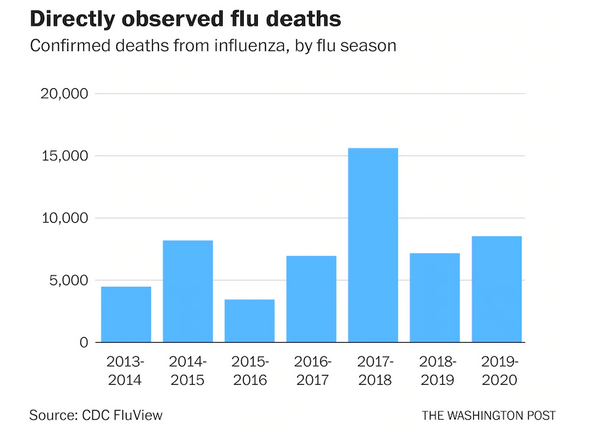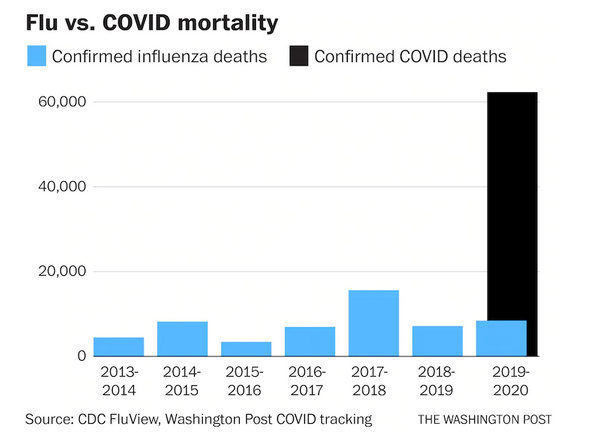~ An intriguing Friday
Fatalities first ~
• Total US covid-19 deaths as of Fri, May 2: 64,283
• Increase in last 24 hours: 1,738 (+ 3%)
--> Deaths fall slightly 2nd day in a row
--> US still at 72 deaths/hr — more than 1/min
...>
How do deaths from influenza and deaths from covid-19 actually compare?
You probably think you know the answer: covid-19 is bad, but the flu is bad every year.
What you think you know about flu-death numbers is wrong. It's become the conventional wisdom — flu deaths have become a political billyclub.
The conventional wisdom is wrong.
This is why we need good reporters, who get puzzled and get curious.
Flu season spans winter (reported across the new year):
2018-19: 34,157
2017-18: 61,000
2016-17: 38,000
2015-16: 23,000
Confirmed influenza deaths by season (estimated deaths in parenthesis):
2018-19: 7,172 (34,000)
2017-18: 15,620 (61,000)
2015-16: 3,448 (23,000)
If you add up all the figures, they come to about 56,000.
Seven seasons of confirmed flu deaths are less than 9 weeks of confirmed covid-19 deaths.

Story is here:
washingtonpost.com/business/2020/…

As @_cingraham explains in the story, Ingraham didn't stumble on this himself.
The idea came from an emergency room physician with Harvard's Brigham & Women's hospital named Jeremy Faust (@jeremyfaust).
'I had almost never seen anyone die of the flu. I could only remember one tragic pediatric case.'
The non-stop battle over whether the coronavirus is 'not much worse' that the flu is over.
blogs.scientificamerican.com/observations/c…
Not in how they handle or report their data. It's all there.
Flu death numbers are estimates & ranges, based on algorithms.
Covid-19 deaths are counted.
And thanks to @_cingraham for his journalism.
This should change that conversation permanently.
That's been controversial.
That's been controversial.
That, of course, is not in anyway how we account for flu deaths. We just didn't realize it.
That's a final significant point: The question of who died of what, and on what basis to make that judgment, doesn't seem like a question for amateurs.
Professionals do this all the time.
And the people who treat both every year knew this.
Now a couple people have shown us the very real data that establishes it.
washingtonpost.com/business/2020/…
There's some news here, too.
• Total confirmed US cases, Fri, May 1: 1,097,841
• Increase in cases in last 24 hours: 33,508 (+3%)
--> New reported cases rise, 4th day in a row
--> 3rd highest day of reported new cases in US in the pandemic
You know what else is up steadily? Daily tests performed.
At some point, the increase in tests will make it look like there are more cases — but we'll be finding cases we weren't finding (or confirming) previously.
This data is hard to tease out and hard to interpret.
Why? We don't have enough tests. We don't have a great random sampling of people across the country, to tell us how widespread the coronavirus infections are.
We're flying blind.
For 2 days below:
>Tests performed
>New cases reported
>Percent positive tests of total performed
Friday, May 1
> 305,118
> 33,508
> 11.0%
Friday, Apr 17
> 157,920
> 28,951
> 18.3%
Clearly, whatever our recent previous 'base level' of new cases was, some of Friday's spike comes from expanding testing to a new kind of person.
That simple comparison shows us the positive rate is falling.
That would tell us that the coronavirus really was in retreat. (It would also mean total new cases was falling, of course.)
--> Expanding testing capacity every day by tens of thousands
--> Starting to test people with much less serious symptoms, or no symptoms at all
We're changing a lot of variables in the testing mix at once.
• New tests performed Fri, May 1, 2020: 305,118
• Days over 200,000 tests a day:
> 4 out of 4
> 7 out of 8
• Only the 2nd day in the pandemic with total tests reported at over 300,000 in a single day (the other: Wed, Apr 22)
That was a reporting backlog.
It's an organic increase, showing increased testing ability and testing determination across the states.
Friday, 18 US states + DC hit an absolute record for tests performed, or a 'local' high.
FL
GA
IA
SC
TX
All those states are either open for business, with some rules, or are about to.
All those, plus 13 more, appear to be building more & more testing ability.
The work of Christopher Ingraham and Jeremy Faust MD seems very significant.
We'll look at which states are still seeing case increase tomorrow. And review Georgia's progress as the pioneer in reopening.
Confirmed influenza deaths (the comparable number) average about 8,000 a year. We do a lot to contain the flu — the vaccine is free across the country.
We're at 64,000 deaths — while taking the most extreme containment measure (or nearly) we could all envision.
Covid-19 deaths will be 10x the flu, or much worse.
Imagine what they'd be without this effort?
The economic harm can be managed. That's part of the job of the government in responding to the pandemic—adequate financial support. If you follow the thread, you know we've dealt with that at length.
Staying-at-home is about the disease.
Christopher Ingraham points out today that if US fatalities fall at exactly the rapid pace at which they've risen — if US deaths traced an inverted V — we'll get to 128,000 US deaths.
And, for the moment, there is no down slope to cases or deaths.
#





